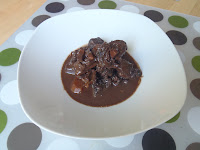 This week I had the opportunity to cook with pig's blood. There's actually more classical applications for blood than you may think.
This week I had the opportunity to cook with pig's blood. There's actually more classical applications for blood than you may think.Fresh blood has a beautiful colour, similar to red wine, but with an opalescent sheen. When heated, the blood turns burgundy, then brown, and eventually black. It coagulates somewhere around 75°C, which makes it ideal for thickening liquids.
Civet: A Gateway Dish
If you're at all squeamish about cooking with blood, this is probably a good dish to start with.
The two things that make a civet a civet are: one, that game is marinated in wine which is later used to braise the meat; and two, that the braising liquid is thickened with blood and used as a sauce. In some cases this is the blood of the animal you are cooking. Collecting the blood of true game animals is difficult because of how they're killed, so pig's blood often stands in as a substitute.
In this case I had some stewing meat from a calf elk that Kevin hunted. Here's the basic procedure.
- Marinate the meat in red wine (I used a Syrah) with sliced onions, carrots, garlic, bay, and black pepper.
- Remove the meat and let it drip dry in a colander.
- Cook bacon in a braising pot. Remove and reserve.
- Brown the game meat in the bacon fat.
- Return the bacon to the pot. Pour the marinating liquid (with sliced vegetables and aromatics) over the meat. Scrap the bottom of the pot with a wooden spoon to capture the delicious fond.
- Cover and simmer until meat is tender, maybe two hours. I also added some reconstituted dried morels partway through the braising.
- Separate the liquid from the meat and vegetables. Remove the bay leaf. Reduce the liquid to concentrate the flavours.
- Use maybe two tablespoons of blood per cup of braising liquid. Temper the blood, then add to liquid. Heat while stirring until the sauce thickens. Be careful not to bring the liquid to a boil, as the blood will curdle and ruin the smooth texture of the sauce.
- Pour the sauce over the meat and vegetables.
The blood adds a very pleasing mineral note that works well with the flavour of the meat.
It's also a dead-simple thickener to use. Even quicker than cornstarch or roux, as it doesn't need to be cooked out. It brought my braising liquid to a nappé consistency in a few moments.
I don't think I've used the word "nappé" on this blog before. Let me explain. "Nappé" (said "nap-EH") is one of the those fantastic French cooking words that doesn't have an acceptable substitute in English. Napper (also pronounced "nap-EH") is the infinitive form of a verb meaning to coat evenly with a thin layer of sauce. When thickening a sauce, the most common way to judge consistency is to simply dip a spoon in the pot, remove, and observe how the sauce clings to the back. In the early liquid stages the sauce will simply slide away, perhaps leaving a few streaks behind. Once the sauce has thickened, it will cleave to the spoon and leave a perfectly even coating. This is a nappé. You should be able to run your finger across this coating and leave a clearly defined streak.




That's not a lot of blood...maybe I can scrounge that somehow from a game animal. I'll have to see. Really cool to hear it's so effective as a thickener. Makes me want to try to harvest it pretty bad, actually. Do you think freezing it in an ice cube tray would suffice for the end-use?
ReplyDeleteI think that would work beautifully. The blood we used had been frozen, and it didn't seem to compromise its thickening power.
ReplyDeleteThe name of the game in harvesting would be getting it chilled as soon as possible, although I guess that's not too much of an issue if you're hunting in November...
I love the idea of a "gateway dish" - it's totally applicable here! Sounds and looks delicious too.
ReplyDeleteI also really appreciate your patient explanation of all these wonderful useful French cooking terms. They say in one word what we say in twelve.
I will echo Mel's appreciation of your teachings, here, Allan. And the information of the blood as a thickener is a huge eye opener for me. Though, I am still not one that is salivating at the thought, and would not "try this at home", I would taste it... and would have to taste it to ever be motivated to try it. I have no frame of reference for this new information, no landing spot for it. I cannot relate the taste in any way. But, Love the learning.
ReplyDelete:)
Valerie